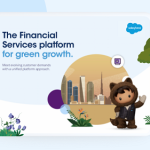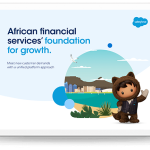CRM adoption can sometimes be an uphill process, as you try to convince your team and upper management to break with their existing habits and embrace the efficiencies they can achieve through automation and a singular overview of your sales process.
At the Salesforce World Tour Live event, Kam Sangha, success director at Salesforce, partnered with Michael Williams, CRM Director at Vitality, to deliver a talk on the best ways of promoting the adoption of Salesforce within your company, as well as ensuring that you optimise the value from doing so.
The talk was structured through a framework of six guiding principles, with Michael explaining how these were applied in Vitality:
- Prepare for change management
- Secure and demonstrate leadership buy-in
- Know your end users
- Commit to simplicity
- Deliver value and be meaningful
- Train, learn and repeat
1. Prepare for change management
Before considering how you’ll utilise your CRM, ask yourself: do you have leadership buy-in? Who are your end users? How are you working towards delivering a meaningful experience to them?
Strategy and vision are the foundation of your approach to management. However, the way you communicate your messaging to end users, such as your leaders, will be critical to the project’s future success. Understanding who you’ll need to lean on, as well as identifying those in your organisation you consider to be your do-ers and early adopters, will also be integral to maintaining sustained interest in the tools and ensuring adoption spreads further.
It will help if you tailor the strategy for communicating to these end users, taking in their needs and experience of using the product. Perhaps they’re more results or process-driven, and highlighting these would be the best way to leverage their attention.
Introducing a Salesforce Design Authority will also get senior leaders and decision-makers to identify the core requirements of the solution; and ensure that any new capabilities being created are fit for purpose. You should also encourage users to present ideas they’re interested in building to encourage constant iteration.
This all may seem daunting, so the recommendation is to start simple with an outline and flow. This creates the opportunity for your team to challenge and understand the reasoning for the structure.
Reflecting on Vitality’s approach to change management, it’s not solely about lobbying but engaging those passionate about the possibilities of the solution. Dashboards were a significant asset, especially those that measure adoption: these allowed Vitality to move past just monitoring logins and understand what users are doing on the platform – maximising the value they could gain. Vitality also employs someone whose job it is to focus on how Salesforce is used and to work on improving the team’s user experience.
2. Secure and demonstrate leadership buy-in
With the blueprint for change management prepared, it’s crucial to keep leadership engaged in the implementation process. Prioritise a top-down approach, making decision-makers your first consideration, as that adoption message will be broadcast furthest by the company’s execs.
What methods can you use to keep people engaged? Dashboards allow for instant visual representation of data and are a great way of getting execs directly involved with the product – and ready to deliver messages to end users. However, these are often underused, with people preferring to use sales emails that are far less effective in communicating the value of the platform.
Slack can also be employed for sharing news of deals won, end-of-quarter successes and customer stories. Doing so publicly, rather than just through email, is a big win and a great way to show that leadership is bought into the solution.
For Vitality, the critical lesson is that communication should be regular and concise. Transparency is crucial to leadership buy-in: document project wins and be honest about what didn’t go right, as this opens up a conversation about how to iterate the solution. Vitality’s communication cadence extends to weekly communications being sent to the immediate senior team and on a bi-weekly basis to the entire organisation – the lesson being to actively demonstrate the value the platform provides.
3. Knowing your end users
Awareness of your end users is crucial. You need to keep them top of mind throughout the adoption process – and cultivate super- and power-users, as they are the ones that will give you qualitative feedback and valuable input into what you should be doing differently.
Vitality’s approach involved creating Salesforce communities based around specific business areas – not just senior executives but their leadership teams as well – which get together monthly. The goal of these communities is to get ideation started in the meetings, building greater possibilities for the platform’s use. When a feature request is brought up in the meeting, it’s essential to get to the reasoning behind why. People should be able to question why things are being designed a certain way and consider the logic of doing so.
It’s also important to understand what people are using – and how they are using it. It is often the case that people find workarounds for tasks that aren’t addressed in the overall design – but if these work satisfactorily, then there is no need to replace them. Or, it may be that the process being asked for could be completely automated – but nobody had considered doing so up until that point. Also, instead of developing a bespoke solution straightaway, see if a pre-existing solution is available – this will save you valuable time down the line and allow you to prioritise the creation of solutions unique to your business.
One approach to keep in mind is ensuring you can quickly change and adapt the solution based on feedback. Go for rapid iteration rather than a waterfall approach from the outset. Utilise surveys and walkthroughs to get feedback and explore the reasoning and how teams could simplify the logic. Your company’s survey cadence should be quarterly or at least twice a year.
Survey questions can be very straightforward, such as:
- What is working for you?
- What is not working for you?
- What do you need that’s missing in the product?
4. Commit to simplicity
The principle of committing to simplicity reinforces the principle that, if your CRM uptake is to be high, then your Salesforce instance should be simple and easy to use. Avoid overwhelming users with dozens of fields when they initially start using the product.
To commit fully to simplicity, don’t go straight to building out a solution. Instead, start with a blank piece of paper that plots out the steps in the process. This way, you can quickly see whether the process you have designed is over-engineered for the problem it is trying to solve.
Quick tips include:
- Consider running the Salesforce optimiser at least once a quarter. It helps to keep your process clean and see what’s been over-customised.
- If using profiles and page layouts, remember to tailor the experience for that particular user group.
- Eliminate unneeded data entry where possible: for example, incorporate Outlook integrations to avoid entering the same data into different systems.
- Use the mobile app to allow users to do things on the go, rather than having to wait until they are back in the office.
5. Delivering Value
To achieve true value from your CRM experience, you’ll need to provide an intuitive experience for your end users. Ensure you organise information so the sales team can input deals within a few clicks. Remember to align the needs of your decision-makers and people dealing with the CRM system on a daily basis.
Vitality’s take on this is that it’s all about tracking the value created by the systems your teams are using. Consider the key points you want to track, with value-added as a top-line for measurement. Your team should also be thinking about adding value by simplifying the process through automation or by creating new KPIs.
6. Train, learn and repeat
The final principle involves a process of consistent education on the product, encouraging team members to pass on their knowledge to others. You should see this not just as a one-off exercise but as an opportunity for continuous learning so they can optimise their use of CRM in their day-to-day roles.
Consider a training program to get that message across, whether through short videos or classroom-based instruction. A feedback cycle will also be beneficial and it’s important to understand that different users have learning needs: some may already be familiar with CRM systems while others may need more guidance with the process.
Consider the four stages of the competence learning model as a guideline for how you engage with users at different stages of maturity:
- Unconscious incompetence: you don’t know that you don’t know how to do something.
- Conscious incompetence: you know that you don’t know, and it bothers you.
- Conscious competence: you know that you know how to do something, but completing it takes effort.
- Unconscious competence: when you know how to do something, and it’s second nature.
Vitality used external training teams to educate their staff on Salesforce. It also brought in trainers from other business areas, building greater awareness of the solution and its capabilities across the company. Ultimately, it’s about being able to do what you want in three or four clicks, teaching people how to avoid wasting their time – the sales team should be selling, not being forced to fill out repetitive fields.
Conclusion
If I had to prioritise these guiding principles, I would highlight the need to practise a top-down approach, involving execs from the outset with the product. If they can see the value added by the platform, their influence will encourage greater buy-in amongst their teams.
Sticking close to your end user will also allow you to design your solution with their needs at the top of your mind. The closer you are to your users, the more effective your implementation will be. It will also gain the trust of your user base, ensuring that you get valuable qualitative feedback on their user experience that will allow you to optimise the system.
Finally, remember that the adoption process will require a high degree of iteration, so be ready for change based on that feedback.
If you can do all of this, then you’ll soon find that it’s smooth sailing in your CRM adoption programme.
























